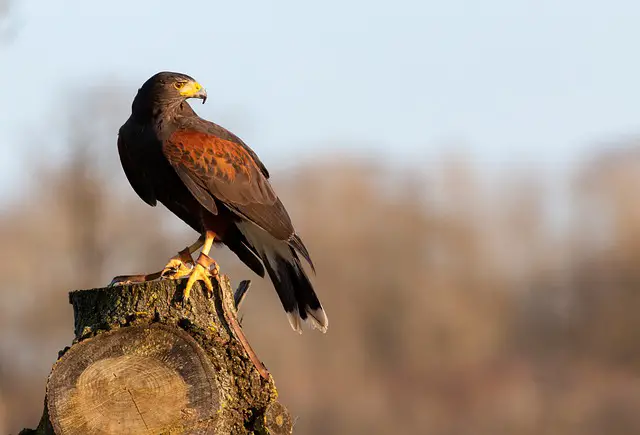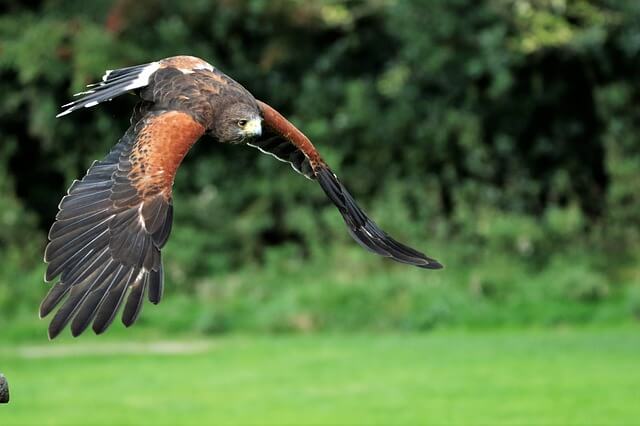Get ready to dive into the world of Harris’s Hawks with these intriguing and entertaining tidbits. These social and intelligent raptors are known for their remarkable behaviors and unique characteristics.
Whether you’re a bird enthusiast or just curious about the natural world, these facts will pique your interest and deepen your appreciation for these incredible birds. Join us as we explore 60 fun facts about Harris Hawks.
Table of Contents
Harris Hawk (Overview)
Facts About Harris Hawks
| Characteristics | Description |
|---|---|
| Identification | Harris’s Hawks have dark brown plumage, with reddish-brown feathers on the wings and upper thighs. The upper tail coverts are almost black with a white rump and a white band on the tail. When viewed from underneath, the inner wings and underwing coverts are reddish-brown. |
| Length | 18.1-23.2 inches (46-59 cm). |
| Weight | 18.2-31.0 ounces (515-880 g). |
| Wingspan | 40.5-46.9 inches (103-119 cm). |
| Taxonomy | Kingdom: Animalia, Phylum: Chordata, Class: Aves, Order: Accipitriformes, Family: Accipitridae, Genus: Parabuteo, Species: P. unicinctus, Binomial Name: Parabuteo unicinctus (Coenraad Jacob Temminck 1824), Scientific Name: Parabuteo unicinctus. |
| Range | Southwestern United States, Mexico, Chile, Argentina, Brazil, and Western Europe. |
| Migration | Harris Hawks live in the United States and Mexico, but migrate to South America for the winter. Their migration is driven by the need for prey items, such as small mammals or reptiles, which cannot survive harsh northern winters. |
| Habitat | Their habitat includes open country, deserts, chaparral, forest edges, and oak savannahs. |
| Diet | Their diet consists of large insects, small mammals such as squirrels, desert cottontail, and mice. They may also prey on larger animals like great blue herons, jackrabbits, young wild turkeys, quail, or doves when opportunities arise. |
| Global Extent of Occurrence | 34,100,000 km2 (13,166,083.6 sq mi). |
| Global Breeding Population | Estimated 920,000. |
| Conservation Status | Listed as Least Concern (Population is declining). |
| Lifespan | In the Wild: 10–12 years of age; In Captivity: 20–25 years of age. |
| Breeding Period | March through June. |
| Incubation Duration | 31–36 days. |
| Nestling Duration | 44–48 days. |
| Chicks Fledge | 45–50 days. |
| Clutch Size | 2–4 eggs. |
| Egg Color | Bluish-white. |
| Nesting Habits | Harris’s Hawks typically breed from one to three times a year. Females are polyandrous, sometimes having more than one mate at a time. Nests are found in palo verde or mesquite trees, 12–25 feet above the ground, and occasionally in saguaro cacti. Both sexes participate in nest building, which includes sticks, yucca plant parts, stems, bark, twigs, grass, moss, leaves, and plant roots. Incubation is mainly done by the female, with eggs hatching between 31 and 36 days. Young birds begin to explore their surroundings outside the nest at 38 days, and they fledge at 45 to 50 days. It’s common for the young to stay with their parents for up to three years. |
- Scientific Name: The scientific name for Harris’s Hawks is Parabuteo unicinctus, reflecting their unique characteristics and genus classification.
- Behavioral Adaptations: Harris’s Hawks exhibit an interesting behavior known as “back stacking.” This phenomenon is primarily observed in Arizona and New Mexico and involves birds perching on top of each other, providing an elevated vantage point for spotting prey or water sources in arid regions.
- Territorial Range: These hawks establish territories that can encompass several square miles, often encompassing open country, deserts, chaparral, forest edges, and oak savannahs.
- Exceptional Eyesight: Harris’s Hawks possess excellent color vision, which is one of the best among animals. Their vision is so sharp that they can perceive details and colors, making them efficient hunters.
- Group Names: A collective group of Harris’s Hawks is sometimes referred to as a “kettle of hawks.” This term highlights their sociable nature, as they are one of the few raptor species that hunt cooperatively.
- Nesting Locations: These hawks construct nests in various locations, including trees, shrubs, and even saguaro cacti. Their adaptability in choosing nesting sites is essential for their survival in diverse environments.
- Breeding Frequency: Harris’s Hawks have the capacity to breed from one to three times in a single year, depending on factors like food availability and environmental conditions.
- Dietary Preferences: While their primary diet consists of small mammals such as squirrels, rabbits, rats, and mice, they display dietary flexibility and will opportunistically consume birds if the opportunity arises.
- Predatory Techniques: Harris’s Hawks employ an array of hunting strategies. They use perches to scout for prey, coordinating their actions as a group to capture it. This cooperative hunting behavior makes them highly successful hunters.
- Parental Roles: Both male and female Harris’s Hawks play active roles in caring for their young. They share responsibilities such as nest-building, incubation, and feeding.
- Nest Materials: Their nests are constructed from a variety of materials, including sticks, yucca plant parts, and stems. The interior is often lined with bark, twigs, grass, moss, leaves, and plant roots for insulation and comfort.
- Cinnamon Plumage: Juvenile Harris’s Hawks sport cinnamon-brown plumage that gradually transitions to a grayish hue as they mature. This transformation is a visual indicator of their age.
- Family Bonds: Young Harris’s Hawks typically remain with their parents for up to three years, forming strong family bonds and learning valuable hunting skills during this time.
- Unique Features: Their unique white rump and conspicuous tail pattern are distinctive features that aid in both species identification and communication within their family groups.
- Adaptation to Dry Areas: The back stacking behavior exhibited by Harris’s Hawks allows them to overcome the challenges of locating prey and water sources in arid regions, showcasing their adaptability.
- Color Vision: Their exceptional color vision not only aids in hunting but also enhances their ability to differentiate between various aspects of their environment, including the plumage of other birds.
- Mating Call: The male Harris’s Hawk produces distinctive and audible vocalizations during the breeding season, which play a crucial role in communication and pair bonding.
- Nest Lining: The interior of their nests is meticulously lined with materials that provide insulation and comfort for the eggs and nestlings, highlighting their care and attention to reproductive duties.
- Habitat Diversity: Harris’s Hawks are known to inhabit a wide range of ecosystems, from arid deserts to wetlands, showcasing their adaptability to diverse environments.
- Global Population: The global population of Harris’s Hawks is estimated to be between 390,000 individuals and 920,000 breeding birds, highlighting their healthy presence across various regions.
- Conservation Status: These hawks are currently listed as “Least Concern” on the conservation status scale, indicating that their populations are stable and not facing significant threats.
- Lifespan in the Wild: Harris’s Hawks can live up to 10-12 years in the wild, where they face natural challenges, including predation and environmental factors.
- Lifespan in Captivity: When kept in captivity, Harris’s Hawks can live up to an impressive 20-25 years, highlighting the importance of their conservation in captivity programs.
- Breeding Period: The breeding season for Harris’s Hawks typically spans from March through June, varying slightly depending on their geographic location.
- Incubation Duration: Females incubate their eggs for a period of 31-36 days, ensuring the development and hatching of their young.
- Chicks’ Fledging: Harris’s Hawk chicks fledge, or start to fly, at around 45-50 days after hatching, marking the beginning of their independent lives.
- Clutch Size: Each clutch of eggs typically contains 2-4 eggs, although variations can occur depending on factors such as food availability.
- Nesting Habits: Both male and female Harris’s Hawks actively participate in nest-building, contributing to the construction and maintenance of their nests.
- Nesting Material Selection: Materials used for nest construction often include sticks, yucca plant parts, stems, and various vegetation found in their habitat.
- Caring for Hatchlings: After hatching, the female takes the lead in caring for the chicks, ensuring their warmth, nourishment, and protection.
- Chicks’ Plumage Transition: The plumage of Harris’s Hawk chicks transitions from a cinnamon-brown color to gray as they mature, helping to distinguish their age.
- Full Maturity: Harris’s Hawks reach full maturity in approximately four to six years, becoming experienced and efficient hunters.
- Global Range Adaptation: Their ability to thrive in a variety of ecosystems worldwide underscores their adaptability and ecological significance.
- Distinctive Tail Pattern: The white rump and tail pattern of Harris’s Hawks are not only unique but also serve as visual signals during group activities and aerial displays.
- Social Structures: These hawks exhibit complex social structures, often forming family groups that cooperate during hunting and nesting.
- Parental Teaching: Young Harris’s Hawks learn crucial hunting techniques from their parents and older siblings, ensuring their survival skills are honed.
- Human Interaction: Harris’s Hawks have adapted to human presence in some areas, readily utilizing urban environments for nesting and hunting.
Frequently Asked Questions
Are Harris hawks smart?
Harris’ hawks are notoriously intelligent birds, so much so that they have been used in the past to hunt which is why they were domesticated by Native Americans for this purpose. Their intelligence is not their only noteworthy quality, though, as Harris hawks also have amazing sight and hearing.
Are Harris hawks affectionate?
Harris’ hawks have been known to be aggressive birds. Studies have shown that when raised by humans or trained from an early age to hunt cooperatively with humans, these birds can be quite docile, but in the wild they are solitary and aggressive.
Are Harris hawks easy to train?
Harris’ hawks are one of the most popular bird breeds for falconry, as they are easy to train and handle. Falconers also use Harris hawks because they can be flown in close proximity to their prey without scaring them off or spooking them. In fact, a skilled Harris hawk is so stealthy that it will even take down its prey without being seen.
Are Harris hawks good pets?
Harris’ hawks are not a bird you should keep as a pet. They need to hunt and will get frustrated when they can’t find food for themselves. They also can become aggressive and territorial, making them unsuitable for most households.
Why do Harris hawks stack?
Harris’ hawks are a unique bird that often will often stand on top of each other to see farther than they would otherwise be able to with their own eyesight alone. They use this ability in order to get an advantage over their prey and enemies.




